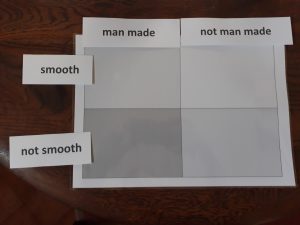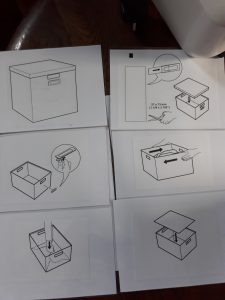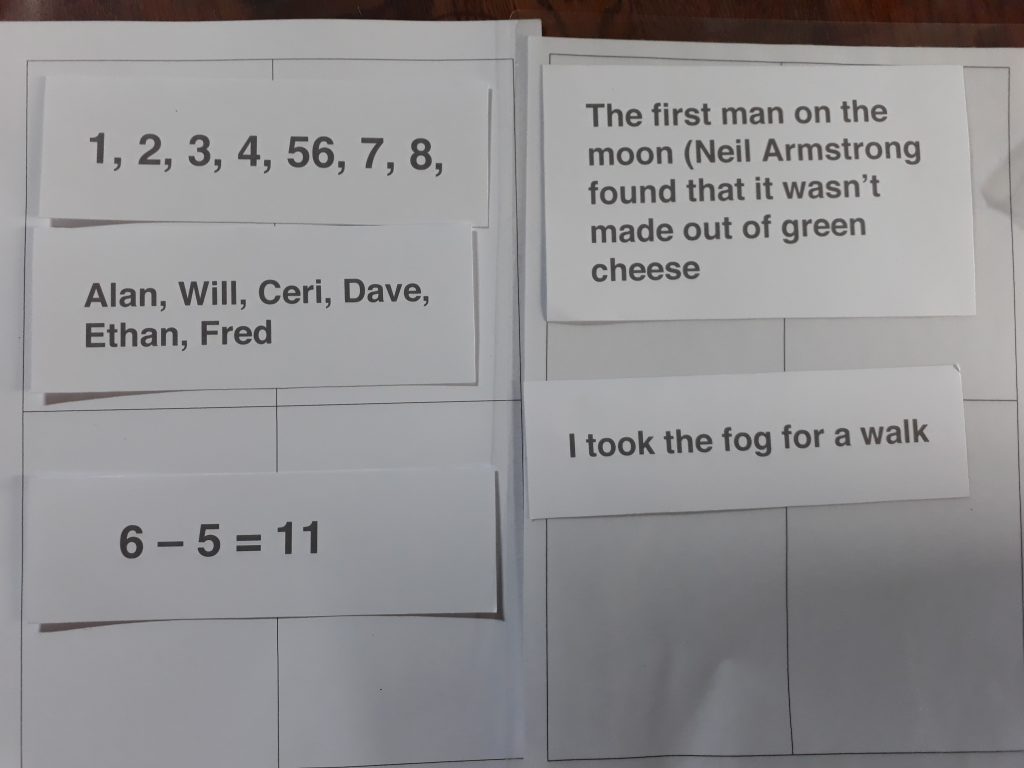When we talk about teaching younger children to code what we actually mean is teaching them to think logically, to recognise patterns and sequences, to break tasks down into smaller parts and to solve problems. We call this Computational Thinking.
In many cases you are ALREADY DOING THIS without realising it. It’s easy to tweak your activities slightly to embed some coding into your everyday lessons.
Below you will find the ideas and resources presented in the Taccle3 “An intro to coding for younger children” training workshop in Tallinn.
Patterns
 Sorting exercises
Sorting exercises
-
Collect a bag of stuff; cotton wool, leaves, polystyrene, shells, plastic toy, scrap of material, feather, pinecone, buttons, tin-foil, etc.
These can be sorted into eg. man-made/natural, hard/soft, sinks/ floats.
-
Collect a random assortment of lego pieces.
How many different ways can these be sorted? Colour, shape, size, number of studs…
-
 Next use a 2×2 matrix to sort the items by more than one category.
Next use a 2×2 matrix to sort the items by more than one category.
Start with man made vs natural and smooth vs rough before introducing the concept of ‘Not’. So hard vs soft becomes hard or not hard, long vs short becomes short or not short and so on.
You can use our ready made categories here.
-
Cut out some polygons – Here are some we made earlier
Another simple pattern to recognise is that the more sides a polygon has, the closer it becomes to a circle. Not only is it a simple exercise into which you can include shape recognition and counting the number of sides, you’ll also be laying the foundations for understanding calculus!
Abstractions and Generalisation
This is the process of stripping something down to its essential characteristics or the features specific to that thing.
-
Describe an unambiguous word in as few words as possible

You could use fruit – describe a fruit one characteristic at a time and see if the other person can guess in as few turns as possible.
eg. a banana. It’s fruit (yes yes I know its a herb shhh), it’s yellow (could be a lemon or a grapefruit at this point), it’s curved (you’ve probably got it by now).
The same game works with pets, farm animals, people who help us, people in the class…
-
List the rules to a simple game
Explain as simply as possible, how to play ‘Simon Says’, ‘Scissors, Paper, Stone’, or other simple game. Then have some fun playing them.
Algorithms
-
 Print out and cut up the instructions for a simple recipe, a game, an ‘easy’ furniture flatpack etc. and have your class put the sequence back into the correct order.
Print out and cut up the instructions for a simple recipe, a game, an ‘easy’ furniture flatpack etc. and have your class put the sequence back into the correct order.
Here is one we made for demonstrating with teachers so they may be too difficult for your classes but you’ll get the idea.
-
Use picture cards and simple coding symbols to create stories

This one says IF its Raining AND Sunny THEN Rainbow.
Follow the links to download some of the Pictures and Symbols there are more detailed descriptions of how to use the cards her too; IF and THEN, NOT, AND.
Decomposition
-
Make an Easter Card
Or any card for that matter. The key is to look carefully at how you make it. Are there some steps which have to be completed in order? Do you write the verse first or decorate the front? Do the bunny ears have to be fixed in place before the googly eyes or afterwards? Steps which have to be completed in a certain order are called sequential. Steps which can be completed in any order are parallel processes. If you worked on the card with a partner, one person could be writing a poem to stick inside whilst the other person decorated the front. With a little thought you can turn any craft activity into a lesson in computational thinking!
Easter card printables available here.
-
Look at the box of a computer game
This is a discussion activity. Look at the box and the instruction manual for a game. There will be a few pages of credits. Talk about the different possible roles of the people who worked together to make the game. Someone had to draw the pictures, design the characters, think of a story, maybe design weapons or special moves, another group worked on selling the game, making a tv advert, making merchandise… you will be having a conversation about decomposition or breaking something down into smaller tasks.
You can have the same discussion about a cartoon or a film or a car or any other product or complex process.
Debugging
Debugging is finding mistakes and fixing them. you could have a discussion about the sorts of mistakes that might happen and why it’s important to find and correct them. What could go wrong when you are making a cake? Wrong amounts, wrong ingredients, wrong timing, wrong temperature… What about when we write sentences or stories?
Can you spot the mistakes below?
